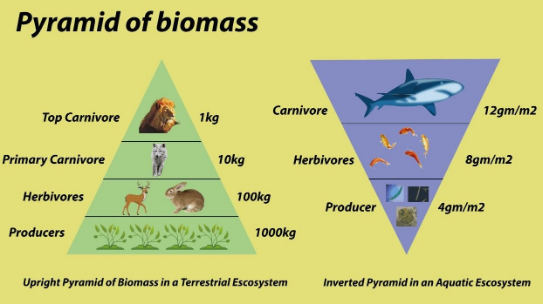
In a grass-deer-tiger food chain, grass biomass is one tonne. The tiger biomass shall be
(a) 100 Kg
(b) 10Kg
(c) 200 Kg
(d) 1Kg
Answer
439.5k+ views
Hint: The graphical representation of the organism that shows their relationship at different trophic levels is called the ecological pyramid. They are differentiated on the basis of their energy, biomass, and numbers.
Complete answer
The graphical representation of biomass present per unit area at any time in different trophic levels is called the pyramid of biomass. The pyramid of biomass in the case of the terrestrial (land) ecosystem is upright (more at base and less at top) while in the case of the aquatic ecosystem it is found to be inverted (lower at the bottom and more at top). According to the law of
Additional information
Other than the pyramid of biomass there are two other types of pyramids, the pyramid of energy, and the pyramid of biomass.
-A pyramid of energy is a graphic representation of the amount of energy trapped per unit of time and area in different trophic levels of a food chain. Energy is measured through kcal/m^{2}/year. The energy decreases as the trophic levels increase, this is explained with the help of the second law of thermodynamics. In the pyramid of energy, only
-In an ecosystem, the individuals of the food chain present at different trophic levels are differentiated based on the number of individuals present there, this can be explained through a graphical representation called the pyramid of numbers. The pyramid is upright (straight) in the case of the pond ecosystem while it is inverted (spindle-shaped) in the case of the forest ecosystem.

So, the correct answer is ‘10Kg’.
Note:
The ecological pyramids are helpful in observing the patterns or feeding among the organisms of various ecosystems. It can also give us an insight into how inefficient energy transfer is, also the influence that a change in numbers at one trophic level can have on the trophic levels above and below it. It is helpful in studying the changes that are occurring in the environment by comparing them from the data of several years.
Complete answer
The graphical representation of biomass present per unit area at any time in different trophic levels is called the pyramid of biomass. The pyramid of biomass in the case of the terrestrial (land) ecosystem is upright (more at base and less at top) while in the case of the aquatic ecosystem it is found to be inverted (lower at the bottom and more at top). According to the law of
Additional information
Other than the pyramid of biomass there are two other types of pyramids, the pyramid of energy, and the pyramid of biomass.
-A pyramid of energy is a graphic representation of the amount of energy trapped per unit of time and area in different trophic levels of a food chain. Energy is measured through kcal/m^{2}/year. The energy decreases as the trophic levels increase, this is explained with the help of the second law of thermodynamics. In the pyramid of energy, only
-In an ecosystem, the individuals of the food chain present at different trophic levels are differentiated based on the number of individuals present there, this can be explained through a graphical representation called the pyramid of numbers. The pyramid is upright (straight) in the case of the pond ecosystem while it is inverted (spindle-shaped) in the case of the forest ecosystem.

So, the correct answer is ‘10Kg’.
Note:
The ecological pyramids are helpful in observing the patterns or feeding among the organisms of various ecosystems. It can also give us an insight into how inefficient energy transfer is, also the influence that a change in numbers at one trophic level can have on the trophic levels above and below it. It is helpful in studying the changes that are occurring in the environment by comparing them from the data of several years.
Recently Updated Pages
Master Class 9 General Knowledge: Engaging Questions & Answers for Success

Master Class 9 English: Engaging Questions & Answers for Success

Master Class 9 Science: Engaging Questions & Answers for Success

Master Class 9 Social Science: Engaging Questions & Answers for Success

Master Class 9 Maths: Engaging Questions & Answers for Success

Class 9 Question and Answer - Your Ultimate Solutions Guide

Trending doubts
Where did Netaji set up the INA headquarters A Yangon class 10 social studies CBSE

A boat goes 24 km upstream and 28 km downstream in class 10 maths CBSE

Why is there a time difference of about 5 hours between class 10 social science CBSE

The British separated Burma Myanmar from India in 1935 class 10 social science CBSE

The Equation xxx + 2 is Satisfied when x is Equal to Class 10 Maths

What are the public facilities provided by the government? Also explain each facility




